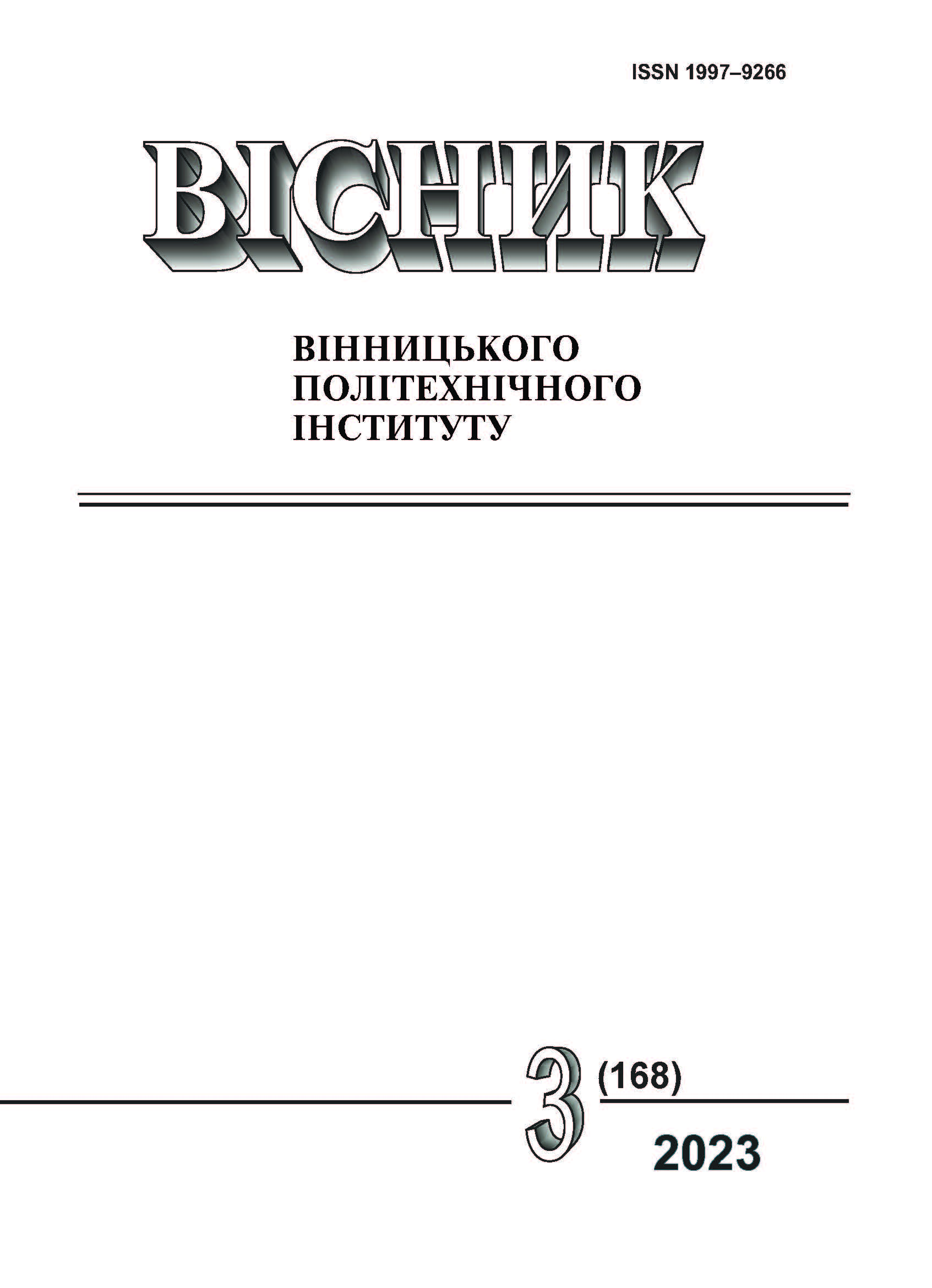Algorithm of Determining the Position of the Extremities of a Stepping Mobile Robot in Space
DOI:
https://doi.org/10.31649/1997-9266-2023-168-3-84-89Keywords:
walking mobile robot, work algorithm, block diagram, mathematical model for determining position in space, geometric center of body mass, limb position, automation, triangle methodAbstract
The article presents an algorithm for determining the position of the limbs of a walking mobile robot (MR) in space, based on a method previously developed by the authors, which is a finite set of triangles for representing each joint of a limb of a walking mobile robot. The proposed algorithm has a linear structure without branches for the step-by-step execution of a certain sequence of actions that allow determining the spatial position of the limbs of a walking MR. The operation of the algorithm is considered on the example of an abstract model of a six-legged walking MR with the same design of three-hinged limbs and a body in the shape of a regular hexagon. This algorithm allows you to automatically calculate and graphically display the position of the MR’s limb in space. The practical implementation of the proposed algorithm is provided in specialized software.
The relevance and importance of the proposed algorithm is determined by the lack of articles and publications in this direction. Known scientific works in most cases are devoted only to solving problems of kinematics and dynamics of walking MRs and building their kinematic models. At the same time, it is necessary to note the lack of a systematic approach to algorithmization and automation of determining the position of the limbs of walking MRs in space, which limits their practical use in real conditions. In this regard, it is assumed that the proposed algorithm for determining the position of the limbs of a walking MR will partially solve this problem, which will contribute to the introduction of MR into various areas of human activity.
The obvious advantages of the proposed algorithm are linearity, simplicity, unbranched structure, its clarity, and ease of software implementation. Application of the algorithm makes it possible to increase productivity and reduce the labor-intensiveness of actions performed when solving the problem of determining the positions of the limbs of walking MRs in space, reducing the time of performed operations and reducing the intellectual load on developers.
References
О. В. Фiляюшкін, «Огляд конструкцій крокуючих роботів,» ΛΌГOΣ, Мистецтво наукової думки, наук. журн., М. А. Голденблат, Ред. № 1 с. 157-160, 2018.
М. М. Поліщук, «Мобільний робот для обслуговування паркових та лісних деревних масивів,» Екологічні науки, № 26, с. 132-137, 2019. https://doi.org/10.32846/2306-9716-2019-3-26-24 .
І. М. Платов, і О. М. Павловський, «Алгоритм руху автономного робота-гексапода для переміщення у вузьких замкнутих просторах,» Вісник КПІ. Серія Приладобудування, зб. наук. пр., вип. 61 (1), с. 61-68, 2021. [Електронний ресурс]. Режим доступу: https://ela.kpi.ua/handle/123456789/46667 .
Ю. Ю. Хазанович, і Ю. В. Киричук, «Алгоритм керування крокуючих роботів,» Погляд у майбутнє приладобудування, зб. пр. XV Всеукраїнської науково-практичної конференції студентів, аспірантів та молодих вчених, 14-15 червня 2022 р. Київ, Україна.: ПБФ, КПІ ім. Ігоря Сікорського, 2022, 213 с.
How Robotics in Logistics Helps Improve Supply Chain Efficiency. [Electronic resource]. Available:
https://www.fingent.com/blog/how-robotics-in-logistics-helps-improve-supply-chain-efficiency/ .
М. М Поліщук, «Автоматизований синтез мобільних роботів довільної орієнтації в технологічному просторі.» дис. д-ра техн. наук: 05.02.02 – Машинознавство. Національний технічний університет України «Київський політехнічний інститут імені Ігоря Сікорського». Київ, 2021, 377 с.
How are Robots Used in Space Exploration. [Electronic resource]. Available: https://blog.bliley.com/robots-used-in-space-exploration .
Ю. Ю. Хазанович, Ю. В. Киричук, і І. Ю. Черепанська, «Метод визначення положення кінцівок крокуючого мобільного робота у просторі,» Вчені записки Таврійського національного університету імені В. І. Вернадського. Серія: Технічні науки, т. 34 (73), № 1, с. 136-143, 2023. https://doi.org/10.32782/2663-5941/2023.1/21 .
Ю. Ю. Хазанович, і І. Ю. Черепанська «Визначення просторового положення кінцівок крокуючого мобільного робота,» Автоматизація та комп’ютерно-інтегровані технології – 2023, матеріали ІХ Міжнародної науково-прак тичної конференції молодих учених, аспірантів і студентів (АКІТ – 2023), Київ, КПІ ім. Ігоря Сікорського, 19 квітня 2023 р, 126 с. : іл. ISBN 978-966-990-066-1 .
Zihao Yang, MinghaiYuan, Xinhui Shi, Zenan Yang, and Mengyuan Li, “Mechanism Design and Kinematics Analysis of Spider-like Octopod Robot,” IOP Conf. Series: Journal of Physics: Conf. Series 1314 012109, 2019. https://doi.org/10.1088/1742-6596/1314/1/012109 .
Yaguang Zhu, Ziqi Fang, and Liang Zhang, Dynamic Jump Motion Control of a Jumping Spider Robot with Redundant Degrees of Freedom, 2019. https://doi.org/10.1109/CAC48633.2019.8996895 .
Abdelrahman Sayed Sayed, et. all, “Experimental Modeling of Hexapod Robot Using Artificial Intelligence,” A.-E. Hassanien et al. Eds., AICV 2020, AISC 1153, pp. 26-36, 2020. https://doi.org/10.1007/978-3-030-44289-7_3 .
Yaguang Zhu, Long Chen, Qiong Liu, Rui Qin, and Bo Jin, “Omnidirectional Jump of a Legged Robot Based on the Behavior Mechanism of a Jumping Spider”, Appl. Sci., no. 8, 51, 2018. https://doi.org/10.3390/app8010051 .
Munadi, Ismoyo Haryanto, Toni Prahasto, and Analisa Kinematik, “Dinamik Dan Metode Gerak Kaki Model Snooper Hexapod Robot,” ROTASI Jurnal Teknik mesin , vol. 17, no. 3, pp. 137-144, Juli 2015, https://doi.org/10.14710/rotasi.17.3.137-144 .
J. Y. Kim, “Dynamic Balance Control Algorithm of a Six-Legged Walking Robot,” Little Crabster. J Intell Robot Syst., no. 78, pp. 47-64, 2015. https://doi.org/10.1007/s10846-014-0074-1 .
Downloads
-
PDF (Українська)
Downloads: 140
Published
How to Cite
Issue
Section
License

This work is licensed under a Creative Commons Attribution 4.0 International License.
Authors who publish with this journal agree to the following terms:
- Authors retain copyright and grant the journal right of first publication.
- Authors are able to enter into separate, additional contractual arrangements for the non-exclusive distribution of the journal's published version of the work (e.g., post it to an institutional repository or publish it in a book), with an acknowledgment of its initial publication in this journal.
- Authors are permitted and encouraged to post their work online (e.g., in institutional repositories or on their website) prior to and during the submission process, as it can lead to productive exchanges, as well as earlier and greater citation of published work (See The Effect of Open Access).





